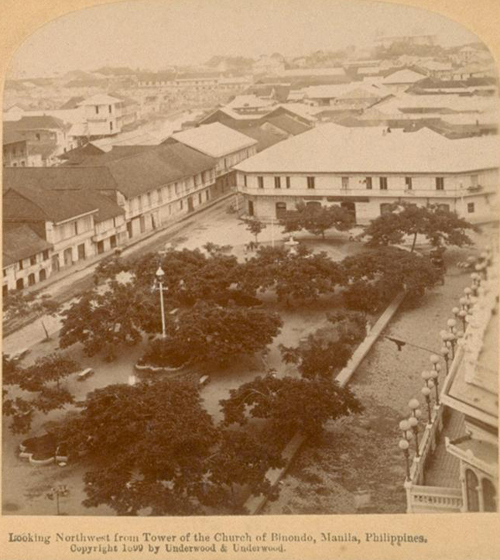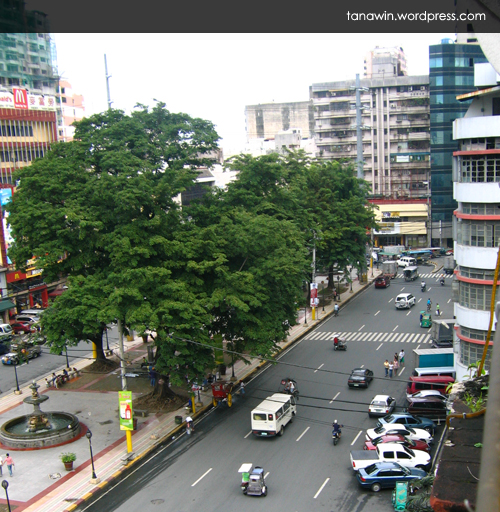The layout design of Plaza Binondo (also known as Plaza Calderon de la Barca and currently known as Plaza Lorenzo Ruiz) and its immediate surroundings is typical of towns established during the Spanish occupation where everything radiated from and revolved around the plaza. Many plazas from the time served as some sort of a front yard for the church, as well as for the town hall, if there ever was one.
The Church, as we see it now, is located off to one end of the plaza. But, take note that the Church and Convent of Binondo once occupied a huge piece of land that included the lots which would later (in the late 1800s) be occupied by the Hotel de Oriente and La Insular Cigar and Cigarette Factory. (That makes Plaza Calderon de la Barca one helluva front yard!)

Plaza Calderon de la Barca (1899) - Used with permission, courtesy of The Bancroft Library (http://bancroft.berkeley.edu/)

Plaza Lorenzo Ruiz in 2008 (Photo taken on September 27, 2008 from the bell tower of Binondo Church)
In Chapter 28 (entitles “The Description Of An Earthquaky City”) of the book “Four Young Explorers or Sight-Seeing In The Tropics” by Oliver Optic (1896), Binondo is described as follows:
“On the north side of the river is the Binondo suburb, as it is called, which is more populous than the old part. The foreign merchants live here, and it is the more important commercial centre. You would hardly know, if you waked from a sleep there, whether you were in a Spanish or an Oriental city, for you would see something of both. Gloomy-looking churches, awkward towers, and heavily built stone houses are mixed up with pleasant cottages in groves of tropical trees. I believe the people are now inclined to build more of wood than stone on account of the prevalence of earthquakes, which shake down the heavier structures, and crush the occupants under the weight of the material.
“As in Burma and Siam, the cottages I mentioned are built on posts; for the land is sometimes inundated, and the water requires a free passage, or it would do more mischief. In the month of August, nearly two feet of water falls on a level; and it makes bad work in the low places. The streets are wide and not paved; and in the rainy season, with a foot or two of water lying loose around, they become very nearly impassable. The houses are built in Spanish fashion, with a central court-yard. They are generally two stories high; for in an earthquaky country like this, where terra firma becomes terra shaky, the people are not encouraged to erect buildings twenty stories high, as in New York and Chicago.”
A short description of Binondo can also be found in Chapter 2 (entitled “All About the Town”) of the book “The Great White Tribe in Filipinia” by Paul T. Gilbert (1903, Jennings and Pye) that reads:
“Near by, and on an emerald plaza, stand the buildings of the Insular Tobacco Company and of the Oriente Hotel. These buildings are the finest modern structures in Manila. Carriages are waiting in the street in front of the hotel, and at the entrance may be seen a group of army officers in khaki uniform, in white and gold, or—very much more modern—olive drab. The dining-room is entered through the rustling bead-work curtain. Here the Chinese waiters, in long gowns glide noiselessly around.”
Also in the book “Our War With Spain For Cuba’s Freedom” by Trumbull White:
Most of the Europeans live in Binondo, a beautiful suburb on higher ground, across the river. There are many native dialects, but the social, official and business idiom is Spanish. The army of Spanish civil, religious, military and naval officials is a leech on the people in the same fashion as it was in Cuba. All the places of profit are monopolized by them, appointments to choice offices in the Philippines being given to those whom it is desired to reward for service to the government in Spain. It is quite well understood that such an appointee is expected to gain a fortune as rapidly as he can, by any method possible, so that he may give way for some one else to be brought over from Spain for a similar reward. The policy is the same as the colonial policy of Spain in Cuba was, and the same results have followed.
Note (on the use of old image):
The photo of Plaza Calderon de la Barca from 1899 contained in this post is used with permission from The Bancroft Library (courtesy of Susan Snyder, Head of Public Service, The Bancroft Library, University of California, Berkley).
The image shown is only a portion of an Underwood & Underwood Stereograph.
The bibliographic details of the original image are as follows:
Title: Looking Northwest from tower of the Church of Binondo, Manila, Philippines. — Photographer: Underwood & Underwood — Place of Publication: New York. — Date of Publication: c1899.
Identifier: 1981.086:71
Collection: Stereographs of the West from The Bancroft Library Pictorial Collection, Underwood & Underwood – 66 stereographsAs per the Conditions of Use found on the Online Archive of California website (which provides access to this image):
By their use of these digital images, texts, audio and video recordings, users agree to follow these conditions of use:
- for purposes of research, teaching and private study, users may reproduce (print or download) in accordance with fair use materials or link to materials from this website without prior permission, on the condition they give proper credit of the collection owning repository
- materials may not be used for any commercial purpose without prior written permission from the copyright owner
- materials may not be re-published in print or electronic form without prior written permission from the copyright owner
- materials may not be mounted on an additional server for public use, or for use by a set of subscribers without prior written permission from the copyright owner





